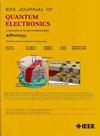基于非对称多量子阱的150通道REC-DFB激光阵列的实验论证
IF 2.2
3区 工程技术
Q3 ENGINEERING, ELECTRICAL & ELECTRONIC
引用次数: 0
摘要
我们提出并演示了用于密集波分复用(DWDM)系统的150通道多波长分布反馈(DFB)激光阵列。该多波长激光阵列的波长间距为0.8 nm (100ghz),符合ITU-T规范。利用重构等效啁啾(REC)技术,在激光腔中心引入一个等效的$\pi $相移,以保证稳定的单纵模工作。此外,该技术还简化了光栅的制作,提高了波长间距的精度。此外,非对称多量子阱(AMQW)技术用于拓宽模态增益谱,从而为所有感兴趣的波长提供足够的增益。实验证明了150通道多波长DFB激光阵列的可行性。在偏置电流为120 mA时,所有通道的侧模抑制比(SMSRs)均在45 dB以上。然后对激光波长进行线性拟合,拟合结果表明,平均通道间距为0.81 nm,与我们的设计偏差仅为±0.01 nm。所有的150个激光器工作在25至65 mA的低阈值电流,这是由于宽波长范围的增益由AMQW结构提供。在200毫安的偏置电流下,所有150个激光器的输出功率都超过10毫瓦。该激光器阵列的远场发散角为32^{\circ} × 26^{\circ}$,洛伦兹拟合线宽为3.35 MHz。据我们所知,本文报道的150通道多波长DFB激光阵列代表了迄今为止报道的DFB激光阵列的最高通道数。该激光器阵列具有稳定的单模工作、精确的波长控制和高信道数等优点,有利于在DWDM系统中应用,提高传输容量。本文章由计算机程序翻译,如有差异,请以英文原文为准。
Experimental Demonstration of 150-Channel REC-DFB Laser Array Based on Asymmetric Multiple-Quantum-Well
We propose and demonstrate a 150-channel multi-wavelength distributed feedback (DFB) laser array for dense wavelength division multiplexing (DWDM) systems. The proposed multi-wavelength laser array with wavelength spacing at 0.8 nm (100 GHz) meets the ITU-T specifications. Using the reconstructed equivalent chirp (REC) technique, an equivalent $\pi $ phase shift is introduced at the center of the laser cavity to guarantee stable single longitudinal mode operation. Besides, the grating fabrication is simplified and the precision of the wavelength spacing is enhanced by the proposed REC technique. In addition, the asymmetric multiple-quantum-well (AMQW) technique is used to broaden the modal gain spectral, thus providing enough gain for all the wavelengths of interest. As a result, a 150-channel multi-wavelength DFB laser array is experimentally demonstrated. At the bias current of 120 mA, the side mode suppression ratios (SMSRs) of all the channels are above 45 dB. The lasing wavelengths are then linearly fitted and the fitted results indicate that the average channel spacing is 0.81 nm, which is only ±0.01 nm deviated from our design. All the 150 lasers operate with low threshold currents of 25 to 65 mA, which is owing to the broad wavelength range of gain provided by the AMQW structure. The output power of all the 150 lasers is over 10 mW at the bias current of200mA. The proposed laser array has a far-field divergence angle of $32^{\circ } \times 26^{\circ }$ and Lorentzian fitted linewidth of 3.35 MHz. To the best of our knowledge, the 150-channel multi-wavelength DFB laser array reported in this paper represents the highest number of channels for a DFB laser array reported to date. The superior properties of the proposed laser array such as stable single-mode operation, precise wavelength control, and high channel count are advantageous for its application in the DWDM systems to enhance the transmission capacity.
求助全文
通过发布文献求助,成功后即可免费获取论文全文。
去求助
来源期刊

IEEE Journal of Quantum Electronics
工程技术-工程:电子与电气
CiteScore
4.70
自引率
4.00%
发文量
99
审稿时长
3.0 months
期刊介绍:
The IEEE Journal of Quantum Electronics is dedicated to the publication of manuscripts reporting novel experimental or theoretical results in the broad field of the science and technology of quantum electronics. The Journal comprises original contributions, both regular papers and letters, describing significant advances in the understanding of quantum electronics phenomena or the demonstration of new devices, systems, or applications. Manuscripts reporting new developments in systems and applications must emphasize quantum electronics principles or devices. The scope of JQE encompasses the generation, propagation, detection, and application of coherent electromagnetic radiation having wavelengths below one millimeter (i.e., in the submillimeter, infrared, visible, ultraviolet, etc., regions). Whether the focus of a manuscript is a quantum-electronic device or phenomenon, the critical factor in the editorial review of a manuscript is the potential impact of the results presented on continuing research in the field or on advancing the technological base of quantum electronics.
 求助内容:
求助内容: 应助结果提醒方式:
应助结果提醒方式:


